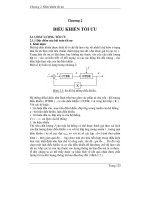Chapter2 a
Bạn đang xem bản rút gọn của tài liệu. Xem và tải ngay bản đầy đủ của tài liệu tại đây (510.43 KB, 40 trang )
Chapter 2: Application Layer
Chapter goals:
conceptual + implementation
aspects of network application
protocols
client server paradigm
service models
learn about protocols by
examining popular applicationlevel protocols
More chapter goals
specific protocols:
http
ftp
smtp
pop
dns
programming network
applications
socket programming
2: Application Layer
1
Applications and application-layer protocols
Application: communicating, distributed
processes
running in network hosts in “user
space”
exchange messages to implement app
e.g., email, file transfer, the Web
Application-layer protocols
one “piece” of an app
define messages exchanged by apps
and actions taken
user services provided by lower layer
protocols
application
transport
network
data link
physical
application
transport
network
data link
physical
application
transport
network
data link
physical
2: Application Layer
2
Network applications: some jargon
A process is a program that is
running within a host.
Within the same host, two processes
communicate with interprocess
communication defined by the OS.
Processes running in different hosts
communicate with an applicationlayer protocol
A user agent is an interface
between the user and the
network application.
Web:browser
E-mail: mail reader
streaming audio/video: media
player
2: Application Layer
3
Client-server paradigm
Typical network app has two pieces: client
and server
Client:
initiates contact with server (“speaks
first”)
typically requests service from server,
for Web, client is implemented in browser;
for e-mail, in mail reader
Server:
provides requested service to client
e.g., Web server sends requested Web
page, mail server delivers e-mail
application
transport
network
data link
physical
request
reply
application
transport
network
data link
physical
2: Application Layer
4
Application-layer protocols (cont).
API: application programming
interface
defines interface between
application and transport
layer
socket: Internet API
two processes communicate by
sending data into socket,
reading data out of socket
Q: how does a process “identify”
the other process with which
it wants to communicate?
IP address of host running
other process
“port number” - allows
receiving host to determine to
which local process the message
should be delivered
… lots more on this later.
2: Application Layer
5
What transport service does an app need?
Data loss
some apps (e.g., audio) can tolerate
some loss
other apps (e.g., file transfer, telnet)
require 100% reliable data transfer
Timing
some apps (e.g., Internet telephony,
Bandwidth
some apps (e.g., multimedia) require
interactive games) require low delay
to be “effective”
minimum amount of bandwidth to be
“effective”
other apps (“elastic apps”) make use
of whatever bandwidth they get
2: Application Layer
6
Transport service requirements of common apps
Data loss
Bandwidth
Time Sensitive
file transfer
Web documents
real-time audio/video
no loss
no loss
loss-tolerant
loss-tolerant
no
no
no
yes, 100’s msec
stored audio/video
interactive games
financial apps
loss-tolerant
loss-tolerant
no loss
elastic
elastic
elastic
audio: 5Kb-1Mb
video:10Kb-5Mb
same as above
few Kbps up
elastic
Application
yes, few secs
yes, 100’s msec
yes and no
2: Application Layer
7
Services provided by Internet transport protocols
TCP service:
connection-oriented: setup required
between client, server
reliable transport between sending and
receiving process
flow control: sender won’t overwhelm
receiver
congestion control: throttle sender
when network overloaded
does not providing: timing, minimum
bandwidth guarantees
UDP service:
unreliable data transfer between
sending and receiving process
does not provide: connection setup,
reliability, flow control, congestion
control, timing, or bandwidth
guarantee
Q: why bother? Why is there a UDP?
2: Application Layer
8
Internet apps: their protocols and transport protocols
Application
remote terminal access
Web
file transfer
streaming multimedia
remote file server
Internet telephony
Application
layer protocol
Underlying
transport protocol
smtp [RFC 821]
telnet [RFC 854]
http [RFC 2068]
ftp [RFC 959]
proprietary
(e.g. RealNetworks)
NSF
proprietary
(e.g., Vocaltec)
TCP
TCP
TCP
TCP
TCP or UDP
TCP or UDP
typically UDP
2: Application Layer
9
The Web: some jargon
Web page:
consists of “objects”
addressed by a URL
Most Web pages consist of:
base HTML page, and
several referenced objects.
URL has two components:
host name and path name:
User agent for Web is called a
browser:
MS Internet Explorer
Netscape Communicator
Server for Web is called Web
server:
Apache (public domain)
MS Internet Information
Server
www.someSchool.edu/someDept/pic.gif
2: Application Layer
10
The Web: the http protocol
http: hypertext transfer protocol
Web’s application layer protocol
client/server model
client: browser that requests,
receives, “displays” Web objects
server: Web server sends objects
in response to requests
http1.0: R FC 1945
http1.1: R FC 2068
PC running
Explorer
http
http
r
requ
es t
es p o
nse
est
u
q
p re
t
e
t
h
ons
p
s
p re
t
t
h
Server
running
NCSA Web
server
Mac running
Navigator
2: Application Layer
11
The http protocol: more
http: TCP transport service:
client initiates TCP connection
(creates socket) to server, port 80
server accepts TCP connection from
client
http messages (application-layer
protocol messages) exchanged between
browser (http client) and Web server
(http server)
TCP connection closed
http is “stateless”
server maintains no
information about past client
requests
aside
Protocols that maintain “state” are
complex!
past history (state) must be
maintained
if server/client crashes, their views
of “state” may be inconsistent, must
be reconciled
2: Application Layer
12
http example
Suppose user enters URL www.someSchool.edu/someDepartment/home.index
(contains text,
references to 10
jpeg images)
1a. http client initiates TCP connection to
http server (process) at
www.someSchool.edu. Port 80 is
default for http server.
1b. http server at host
www.someSchool.edu waiting for
TCP connection at port 80. “accepts”
connection, notifying client
2. http client sends http request message
(containing URL) into TCP connection
socket
3. http server receives request message, forms
response message containing requested
object
(someDepartment/home.index),
sends message into socket
time
2: Application Layer
13
http example (cont.)
4. http server closes TCP connection.
5. http client receives response message
containing html file, displays html.
Parsing html file, finds 10 referenced
jpeg objects
6. Steps 1-5 repeated for each of 10 jpeg
time
objects
2: Application Layer
14
Non-persistent and persistent connections
Non-persistent
HTTP/1.0
server parses request, responds,
and closes TCP connection
2 RTTs to fetch each object
Each object transfer suffers
from slow start
Persistent
default for HTTP/1.1
on same TCP connection:
server, parses request,
responds, parses new request,..
Client sends requests for all
referenced objects as soon as it
receives base HTML.
Fewer RTTs and less slow
start.
But most 1.0 browsers use
parallel TCP connections.
2: Application Layer
15
http message format: request
two types of http messages: request, response
http request message:
ASCII (human-readable format)
request line
(GET, POST,
HEAD commands)
header
lines
Carriage return,
line feed
indicates end
of message
GET /somedir/page.html HTTP/1.0
User-agent: Mozilla/4.0
Accept: text/html, image/gif,image/jpeg
Accept-language:fr
(extra carriage return, line feed)
2: Application Layer
16
http request message: general format
2: Application Layer
17
http message format: respone
status line
(protocol
status code
status phrase)
header
lines
data, e.g.,
requested
html file
HTTP/1.0 200 OK
Date: Thu, 06 Aug 1998 12:00:15 GMT
Server: Apache/1.3.0 (Unix)
Last-Modified: Mon, 22 Jun 1998 …...
Content-Length: 6821
Content-Type: text/html
data data data data data ...
2: Application Layer
18
http response status codes
In first line in server->client response message.
A few sample codes:
200 OK
request succeeded, requested object later in this message
301 Moved Permanently
requested object moved, new location specified later in this message
(Location:)
400 Bad Request
request message not understood by server
404 Not Found
requested document not found on this server
505 HTTP Version Not Supported
2: Application Layer
19
Trying out http (client side) for yourself
1. Telnet to your favorite Web server:
telnet www.eurecom.fr 80
Opens TCP connection to port 80
(default http server port) at www.eurecom.fr.
Anything typed in sent
to port 80 at www.eurecom.fr
2. Type in a GET http request:
GET /~ross/index.html HTTP/1.0
By typing this in (hit carriage
return twice), you send
this minimal (but complete)
GET request to http server
3. Look at response message sent by http server!
2: Application Layer
20









